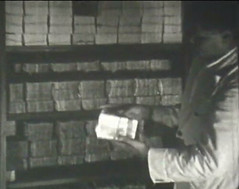
PREV ARTICLE
NEXT ARTICLE
FULL ISSUE
PREV FULL ISSUE
NOTES FROM E-SYLUM READERS: APRIL 1, 2012 Weinberg/Collins The Weinberg/Collins piece had absolutely no place in The E-Sylum. It is unfortunate that you chose to publish it.
I got an earful from some other readers as well. Sorry! I prefer to edit rather than censor, but maybe I should have.
-Editor
German Artist W. Eberbach The German artist referred to in the stories about Paul Manship's "Kultur in Belgium" medal is properly W. Eberbach. Tom DeLorey writes: Does anyone know when in 1917 the Manship KULTUR medal was issued? It reminded me of the Thomas Elder piece I catalogued as DeLorey-97 with the legend: "ONE RESULT OF/ PRUSSIAN KULTUR:/ 150 AMERICANS/ MURDERED/ ON THE HIGH SEAS!/ DOWN WITH THESE/ INTELLECTUAL/ BRUTES!" These first appeared in the Elder sale of 6-29-17. The use of the term is probably coincidental, since it appears to refer to some naval atrocity (the Lusitania, perhaps?), but it is not inconceivable that Elder was inspired by the Manship piece. To read the earlier E-Sylum article, see: MORE ON MANSHIP'S KULTUR IN BELGIUM MEDAL (www.coinbooks.org/esylum_v15n13a09.html) Burglar's Bliss
DAMIN Conference Proceedings Online Our conference at Paris last January is now completely available on internet at www.anr-damin.net . I guess it is the first time that a meeting is completely recorded. Georges adds: The second round table of the DAMIN program Silver Monetary Depreciation and International Relations will take place at Madrid, casa de Velazquez on 16-17 May 2013. The general theme is "The transfers of precious metals and their consequences". Titles and abstracts are to be sent before December 31st, 2012. As for the Paris round-table, the presentations will be video recorded and available on the web site of the program. Proceedings will be published. Some grants are available. All the details on www.anr-damin.net .

Smithsonian Visitors Vote for the Cent When we built our new Numismatic display several years ago, we also wondered about the future of the cent, and we were curious about what members of the public thought about the matter: did they want to retain it or scrap it? We came up with a simple way of testing public opinion (besides making a bit of money for minor expenses). We put up a sign inviting people to vote Yes or No on the future of the cent. Below the sign were two holes, a receptacle beneath each hole. Dropping a cent or other coin in the "Yes" hole meant you wanted to keep the cent, while dropping one in the "No" hole meant that you wanted the denomination to go away. We got some of the most amazing coins - to date, small-denomination pieces from nearly seventy countries, reflecting the varied nationalities of our visitors. But the most surprising thing was the vote itself: it's been running consistently in favor of keeping the denomination by a factor of nearly two to one! I can't explain why people want to retain a coin that does little more than annoy them - other than the fact that it's a piece of money, and there's something in each of us that says that you don't throw away money, even money as humble as this. To read the earlier E-Sylum article, see: 10 REASONS WE NO LONGER NEED THE PENNY (www.coinbooks.org/esylum_v15n13a17.html) The Loeb Classical Library When I downloaded the Loeb Classical Library index in spreadsheet form from the Harvard University Press web site and used it as a cross check, especially for alphabetizing books containing multiple authors' works or books alphabetized by translators name rather than the authors', I found a book not listed in the spreadsheet, Plautus volume V, and that duplicates of two others had been shipped.

a-x clockwise: P is the most common ancient author, followed by A, then C For Latin, it's Cicero, then the others; "Greek, Plutarch." Sweden's Cashless Economy This was certainly our experience. When Kathy & I took a cruise a few years ago from London to Stockholm via St Petersburg,, when we got to Stockholm I went to a newsstand near the Grand Hotel (where we stayed) to buy a newspaper after first changing some dollars for local currency, I needn't have. At the newsstand, someone bought a paper (in Swedish) and provided a credit card for the 50 cent purchase. Then another person did it, and another. They obviously have found a way to beat the minimum charges of Mastercard, Visa and American Express.

Wayne Homren, Editor The Numismatic Bibliomania Society is a non-profit organization promoting numismatic literature. See our web site at coinbooks.org. To submit items for publication in The E-Sylum, write to the Editor at this address: whomren@gmail.com To subscribe go to: https://my.binhost.com/lists/listinfo/esylum All Rights Reserved. NBS Home Page Contact the NBS webmaster 
|
